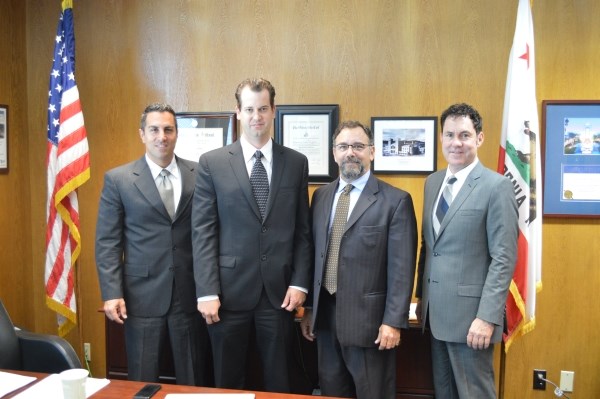Politics of Plating in California
California finishers converge on state capital.
#pollutioncontrol #masking #economics
Norm Plotkin and Bryan Leiker were handing out six-page spreadsheets to their assembled group of surface finishers on the steps of the California state capital building in Sacramento much like a head coach and offensive coordinator would do getting their team prepped for the big game.
Plotkin, the executive director of the Metal Finishing Association of Southern and Northern California, and Leiker, president of the MFASC chapter, were preparing to lead their teammates into a series of several dozen meetings and visits with their state senators and assemblymen to talk metal finishing and regulation.
Featured Content
For Leiker, Sales and Marketing Director at K&L Anodizing in Burbank, a third generation, family-owned business founded by his grandfather “Lefty” in 1950, it’s a matter of meeting state officials and building relationships.
“We want to build new relationships with the people at the statehouse and maintain the ones we already have,” he said. “The message we want to get across is that the surface finishing industry contributes $15 billion to the California economy, employs over a hundred thousand Californians and is very important to, among others, the aerospace and defense industry, which has again seen rapid growth in California.”
WATCH THE VIDEO
The annual Legislative Action Day for the California NASF chapters is not new, but the renewed commitment was evident in May when Plotkin led the group of a dozen or so platers and suppliers into the state capital to chat with senators and assemblymen in meetings that had been arranged several weeks and days prior to their arrival by the associations’ long time contract lobbyist, Jerry Desmond.
First, Plotkin met the previous evening with the group, including MFANC president Terry McGuiness, who also served to gather his northern brethren for the annual capital meetings. They planned their visits for the following day and talked strategy.
Plotkin had more than 20 years of legislative and advocacy experience, running a full-service lobbying, association management, government relations and communications firm based in Sacramento.
He also worked as a consultant for the California state assembly on both the insurance and health committees, a role that brought him close to the assemblymen and senators that he and the metal finishing groups were now lobbying.
Click below to view a slideshow of the images
“It’s my old stomping ground, so I kind of knew all the nooks and crannies of where everything was,” Plotkin said. “It’s always fun to go back and visit the people whom I’ve known for a long time.”
Leiker said he noticed a renewed energy level during this year’s visit with Plotkin at the helm, but the mission was still the same.
“You could sense that these state officials were really listening to what we had to say,” he said. “There was a lot more of a connection made this time around. The story we had to tell was being heard.”
One of those people Leiker was glad to sit down with was Assemblyman Mike Gatto, who represents the 43rd District where Leiker’s business is located. They spoke at length on issues facing not only the metal finishing industry, but also on business matters in general.
“That was an important meeting for me, personally, because he is my assemblyman,” Leiker said. “It’s important for both of us to put a name with a face. I want to build a solid working relationship with Mike going forward, he is a moderate, get things done legislator with a bright future.” “In fact, we have a planned shop tour with Mike in June,” Leiker continued.
Plotkin said the one day capital visit does not end the association’s lobbying efforts for the year. He said the group will continue to reach out to the senators and assembly members through their lobbyist who will attend hearings and conferences all throughout the year on matters that impact the finishing industry and the group will return to Sacramento if a policy issue arises that requires action.
“The message that was heard – and the one that we will continue to tell ‑ is that the finishing industry is so vital to other California industries such as aerospace, defense, tech, commercial and so many others,” Plotkin said. “Once we have made that connection with them on the importance of our industry to the entire state, the fact that metal finishing products are in literally everything, then we have made a big step in getting heard in the future. But we’ll work on this every day and every week from here on out.”
RELATED CONTENT
-
Preventing Anodizing Cathodes from Turning Red
While the red color may not be desirable, anodizing expert Drew Nosti says it poses no particular problem to a successful anodizing process.
-
Aluminum Anodizing
Types of anodizing, processes, equipment selection and tank construction.
-
Cleaning, Pretreatment to Meet Medical Specs ISO 13485 or FDA 21 CFR820
Maximilian Kessler from SurTec explains new practices for industrial parts cleaning, metal pretreatment and decorative electroplating in the medical device industry.



















